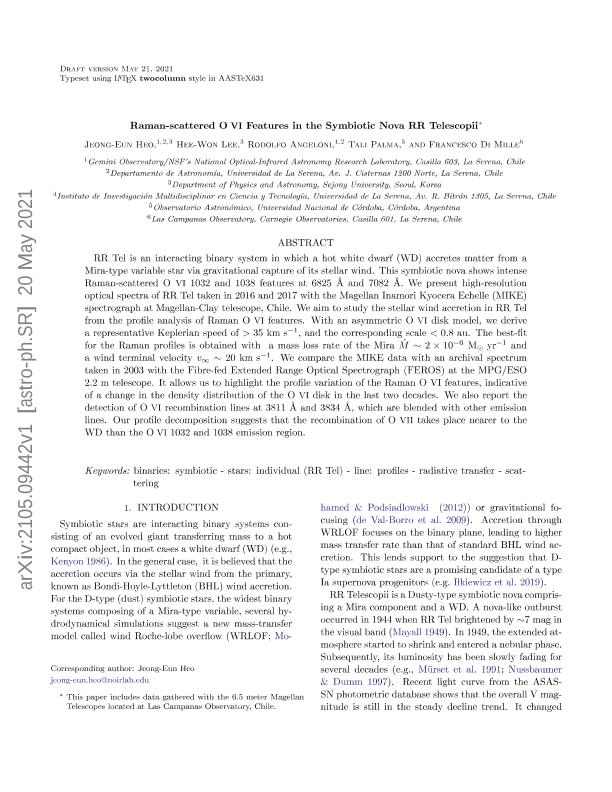Mostrar el registro sencillo del ítem
dc.contributor.author
Heo, J. E.
dc.contributor.author
Lee, H. W.
dc.contributor.author
Angeloni, R.
dc.contributor.author
Palma, Tali

dc.contributor.author
Di Mille, F.
dc.date.available
2022-04-29T13:35:54Z
dc.date.issued
2021-07
dc.identifier.citation
Heo, J. E.; Lee, H. W.; Angeloni, R.; Palma, Tali; Di Mille, F.; Raman-scattered O VI Features in the Symbiotic Nova RR Telescopii; IOP Publishing; Astrophysical Journal; 915; 2; 7-2021; 105-115
dc.identifier.issn
0004-637X
dc.identifier.uri
http://hdl.handle.net/11336/156110
dc.description.abstract
RR Tel is an interacting binary system in which a hot white dwarf (WD) accretes matter from a Mira-type variable star via gravitational capture of its stellar wind. This symbiotic nova shows intense Raman-scattered O VI 1032 and 1038 features at 6825 ˚A and 7082 ˚A. We present high-resolution optical spectra of RR Tel taken in 2016 and 2017 with the Magellan Inamori Kyocera Echelle (MIKE) spectrograph at Magellan-Clay telescope, Chile. We aim to study the stellar wind accretion in RR Tel from the profile analysis of Raman O VI features. With an asymmetric O VI disk model, we derive a representative Keplerian speed of > 35 km s−1 , and the corresponding scale < 0.8 au. The best-fit for the Raman profiles is obtained with a mass loss rate of the Mira M˙ ∼ 2 × 10−6 M yr−1 and a wind terminal velocity v∞ ∼ 20 km s−1 . We compare the MIKE data with an archival spectrum taken in 2003 with the Fibre-fed Extended Range Optical Spectrograph (FEROS) at the MPG/ESO 2.2 m telescope. It allows us to highlight the profile variation of the Raman O VI features, indicative of a change in the density distribution of the O VI disk in the last two decades. We also report the detection of O VI recombination lines at 3811 ˚A and 3834 ˚A, which are blended with other emission lines. Our profile decomposition suggests that the recombination of O VII takes place nearer to the WD than the O VI 1032 and 1038 emission region.
dc.format
application/pdf
dc.language.iso
eng
dc.publisher
IOP Publishing

dc.rights
info:eu-repo/semantics/openAccess
dc.rights.uri
https://creativecommons.org/licenses/by-nc-sa/2.5/ar/
dc.subject
SYMBIOTIC STARS
dc.subject
RADIATIVE TRANSFER
dc.subject
SCATTERING
dc.subject.classification
Astronomía

dc.subject.classification
Ciencias Físicas

dc.subject.classification
CIENCIAS NATURALES Y EXACTAS

dc.title
Raman-scattered O VI Features in the Symbiotic Nova RR Telescopii
dc.type
info:eu-repo/semantics/article
dc.type
info:ar-repo/semantics/artículo
dc.type
info:eu-repo/semantics/publishedVersion
dc.date.updated
2022-02-09T14:17:54Z
dc.identifier.eissn
1538-4357
dc.journal.volume
915
dc.journal.number
2
dc.journal.pagination
105-115
dc.journal.pais
Reino Unido

dc.journal.ciudad
Londres
dc.description.fil
Fil: Heo, J. E.. Observatorio Gemini; Chile. Universidad de La Serena; Chile. Sejong University; Corea del Sur
dc.description.fil
Fil: Lee, H. W.. Universidad de Sejong; Corea del Sur
dc.description.fil
Fil: Angeloni, R.. Universidad de La Serena; Chile
dc.description.fil
Fil: Palma, Tali. Universidad Nacional de Córdoba. Observatorio Astronómico de Córdoba. Departamento de Astrofísica Estelar; Argentina. Consejo Nacional de Investigaciones Científicas y Técnicas. Centro Científico Tecnológico Conicet - Córdoba; Argentina
dc.description.fil
Fil: Di Mille, F.. Observatorio Las Campanas; Chile
dc.journal.title
Astrophysical Journal

dc.relation.alternativeid
info:eu-repo/semantics/altIdentifier/doi/https://iopscience.iop.org/article/10.3847/1538-4357/ac03b1
dc.relation.alternativeid
info:eu-repo/semantics/altIdentifier/doi/http://dx.doi.org/10.3847/1538-4357/ac03b1
dc.relation.alternativeid
info:eu-repo/semantics/altIdentifier/url/https://arxiv.org/abs/2105.09442
Archivos asociados
